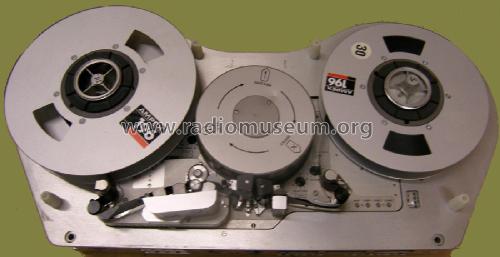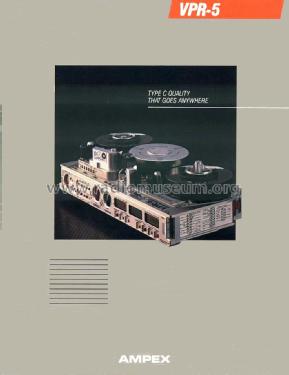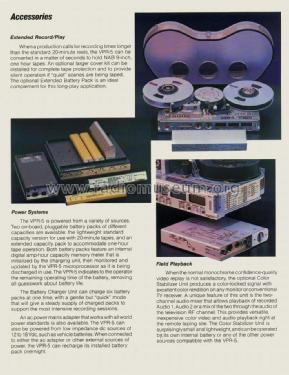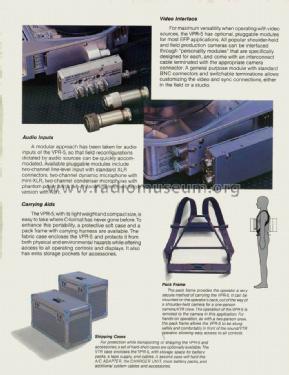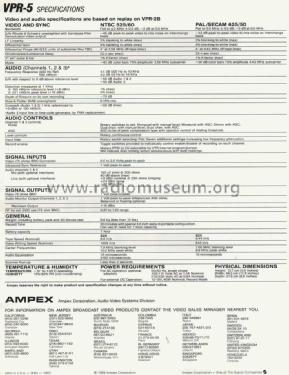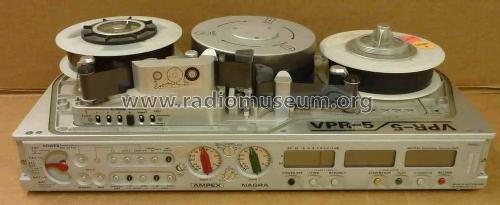Video Portable Tape Recorder VPR 5
Kudelski SA; Cheseaux-sur-Lausanne
- País
- Suiza
- Fabricante / Marca
- Kudelski SA; Cheseaux-sur-Lausanne
- Año
- 1984
- Categoría
- Registrador o reproductor de sonido o visual
- Radiomuseum.org ID
- 266351
-
- Brand: Nagra
- Numero de transistores
- Hay semiconductores.
- Semiconductores
- Principio principal
- Amplificador de Audio
- Gama de ondas
- - no hay
- Especialidades
- Videograbador y/o Reprod.(cinta)
- Tensión de funcionamiento
- Pilas + jack (etc.) para alimentación externa. / ? / 10 -18 Volt
- Altavoz
- - Este modelo usa amplificador externo de B.F.
- Material
- Metálico
- de Radiomuseum.org
- Modelo: Video Portable Tape Recorder VPR 5 - Kudelski SA; Cheseaux-sur-
- Forma
- Portátil > 20 cm (sin la necesidad de una red)
- Ancho, altura, profundidad
- 442 x 137 x 215 mm / 17.4 x 5.4 x 8.5 inch
- Anotaciones
-
The NAGRA VPR-5 is a remarkable piece of engineering, one can be see in The Metropolitan Museum of Modern Art, New York. It is a video portable tape recorder using 1” magnetic tape in C format. VPR 5 development plans were introduced to professionals at the 1982 IBC convention at Brighton. However its production only begins in 1984. Sony Betacam format using cassettes with ½” tape (more practical) was announced one year before and VPR 5 market suffers with this and with its high price of US$ 45,000. AMPEX, a professional video recorder maker with high quality tradition, made some improvements in initial NAGRA design and VPR 5 was marketed as AMPEX NAGRA VPR – 5.
VPR 5 Main Specifications:
Tape format: 1 inch width tape - helicoidally scan tracks for video heads and linear movement for audio and Time Code heads.Reels: 5.5” to 9” diameter (special reels)
Case: CNC milled anodized aerospace alloy (A7750).
Tape speed: 9.6 ips (NTSC) or 9.44 ips (PAL)
Video writing speed: 1009 ips (NTSC) or 842 ips (PAL)Recording time: 20 minutes with special 5.5” (portable mode reels under the recorder cover) and up to 1 hour using 9” reels.
Video: Direct Colour video recording (without any heterodyning)
Video Systems: two recorders - NTSC and PAL
Video Bandwidth (-3 dB): 6 MHz for PALand 5 MHz for NTSC
Video S/N: 46 dB (NTSC), 43 dB (PAL)
Video Linearity: L.F. 2% blanking to white (max) for NTSC and PALVideo Differential gain: <4 %
Video Moire: -40 dB and sub carrier 3.58 MHz (NTSC) and -36 dB and sub carrier 4.43 MHz (PAL) color bars amplitude 75%Crominance/Luminance delay: < 25 ns
Audio channels: 3 (two stereo channel’s) and another (Line or Time Code)
Audio Bandwidth (-2 dB): 50 Hz to 15 kHz
Audio S/N ratio: 56 dB (channels 1 and 2), 50 dB (channel 3)
Audio distortion: < 1% at 100 nWb/m (reference level 8 dBm)Inputs: Video 75 ohms BNC 0.5 V to 2.5 V peak to peak
Advanced Sync Reference: 1 V peak to peakAudio: MIC- 150 µV (min) - optional interface, 40 dB above (max)
LINE – +8 dBm (nom.) at 25 k with optional interface (-20 dBm (min) + 24 dBm (max)
Metering: 3 LCD panels - I) VU or PPM audio levels; II) machine status; III) tape and battery time left, or time code.Monitoring: Real time audio and video recorded. Video is B&W directly but the accessory NV-V10 (Time Based Corrected Colour) adapt to a colour monitor.
Batteries: 2 types- intelligent battery (normal) fits in a recess of the case; battery 4 Ah (NV-2ACC) in a deeper package
Battery capacity: 1 hour of recording
Energy recovery: when the helical scanning system stop energy is recovered to charge batteries.
Power Supply: 100 – 240 V AC (external AC adapter) 105 VA to 138 VA; or 10V -18 V 40W external DC adapter.
Models: VPR-5 is the original one and VPR-5 MkII is a revised version.
- Peso neto
- 6.8 kg / 14 lb 15.6 oz (14.978 lb)
- Precio durante el primer año
- 45,000.00 dollar
- Mencionado en
- - - Manufacturers Literature
- Autor
- Modelo creado por Moisés Piedade. Ver en "Modificar Ficha" los participantes posteriores.
- Otros modelos
-
Donde encontrará 49 modelos, 46 con imágenes y 21 con esquemas.
Ir al listado general de Kudelski SA; Cheseaux-sur-Lausanne
Colecciones
El modelo Video Portable Tape Recorder es parte de las colecciones de los siguientes miembros.
Museos
El modelo Video Portable Tape Recorder se puede ver en los siguientes museos.
Contribuciones en el Foro acerca de este modelo: Kudelski SA;: Video Portable Tape Recorder VPR 5
Hilos: 1 | Mensajes: 1
If you ever come across the repair of the Ampex Nagra VPR-5 be careful not to just switch it on to see what happens …
For whatever reason, the friction brakes inside the supply- and take-up reel motor assemblies were made from some early silicon material that changed to sticky glue as the decades went by, effectively braking both motors to a standstill. As removing the sticky stuff and replacing it by some other sticky stuff would just open a Pandora’s box, a layer of thin coated plastic sheet does the trick. Polyethylenterephthalat (PET) is the raw material for readily available, silicon-coated plastic sheets with typical thicknesses from 1 to 800 µm.
It is recommended that you do not start the VPR-5 without checking first that the motors move freely. The electronics might break down during the brief period of time between the motors trying to run and the sensors recognising the error and switching off the current. If this happens more than once, damage is unavoidable.
Fortunately, Ampex and Nagra supply ample documentation and each(!) cable is numbered(!). All you need (or get during the process) are strong arms (the documentation folders are heavy) and good eyes (the size of the numbering on the cables is around 1/256th of an inch).
Anexos
- VPR5 (49 KB)
- VPR5_motor_repair_1 (107 KB)
- VPR5_motor_repair_2 (84 KB)
- VPR5_motor_repair_3 (84 KB)
- VPR5_motor_repair_4 (76 KB)
- VPR5_motor_repair_5 (88 KB)
- VPR5_motor_repair_6 (66 KB)
- VPR5_motor_repair_7 (90 KB)
- VPR5_motor_repair_8 (87 KB)
- VPR5_motor_repair_9 (67 KB)
- VPR5_motor_repair_10 (64 KB)
Hubert Eisner, 03.Aug.17
